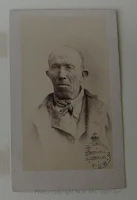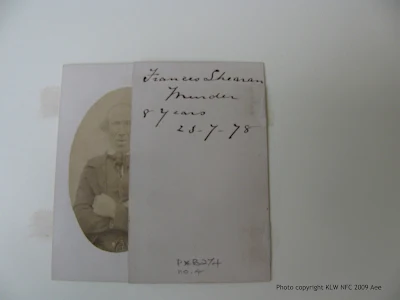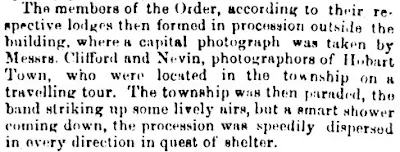An eventful week .... June 26, 1879
 Francis Shearan,
Francis Shearan,
Photo by T.J. Nevin 1878
The Hobart newspaper
The Mercury of June 26, 1879 was a special edition in many ways for Thomas Nevin. It contained a dramatic account of the riot at the Town Hall the previous evening, details of which may well have been supplied to the reporter by Nevin himself who was not mentioned as the Town Hall Keeper probably because he was upstairs keeping the source of the trouble, the Canadian renegade Catholic Pastor Chiniquy, hidden from view of riot leader O'Shea downstairs in the "Irish Corner" of the Hall. Chiniquy did not deliver his scheduled lecture that evening, nor the next.
 The Mercury
The Mercury, 26 June 1879
In the very next column of the newspaper appeared a report on an inquest conducted into the death of prisoner Francis Shearan, together with an eye-witness account of his death by another prisoner Ephraim Booth. Francis Shearan and Ephraim Booth were both photographed as prisoners by T.J. Nevin at various junctures of their careers as habitual offenders. Younger brother Jack Nevin, employed on salary at the Hobart Gaol, assisted Thomas Nevin in producing these photographs for the Gaol records plus duplicates for circulation to regional police and for the central registry of criminals held in the Town Hall at the Municipal Police Office.
THE PHOTOGRAPHS
Two different photographs of Francis Shearan are held at the State Library of NSW in the David Scott Mitchell Collection. These two are among the nine catalogued photographs by T.J. Nevin of Tasmanian prisoners at PXB 274.
 Prisoner photos by T.J. Nevin 1870s
Prisoner photos by T.J. Nevin 1870s
SLNSW © KLW NFC 2009
The earlier one (left) is posed in similar fashion to another by Nevin of convict William Harrison (QVMAG; AOT; Kerr 1992) in which the prisoner is facing the camera with arms crossed. The darkened background of the oval vignette (on left) was used by Nevin more often than the softened edges and clear background (on right) for producing the final carte-de-visite print to be pasted to the criminal's record sheet, although both formats are common and evident in the portraits of his family members and private patrons.
The earlier photograph is a "booking photograph", the classic mugshot of today, taken on Shearan's arrest. He was still dressed in his own clothes, unshaven and in need of a haircut. He was "F.S" - free in servitude - serving an employer in the North West Bay area of the island prison which was Tasmania. Remanded and then sentenced, he was photographed again at the Hobart Gaol (aka the Campbell Street House of Correction) wearing the standard issue blue diamond patterned prison scarf. But which photograph was really taken when? The date transcribed on the verso of the booking photograph merely gives the year "1877". The date on the verso of the photograph on the right documents the date of the sentence handed down. The exact dates on which the photographs were taken cannot therefore be taken as necessarily those on the versos. The date of the sentence was transcribed from a police register or gazette, such as the police gazette records below, and probably by an archivist decades later (1900s).
Neither photograph is tinted, and neither bears any wording about "Port Arthur", a clear indication that Nevin's other cartes of prisoners which bear the inscription ""
Taken at Port Arthur" on verso (QVMAG and NLA collections) were incorrectly labelled by someone in Tasmania after 1907, the year David Scott Mitchell acquired these photographs (among other items by Thomas Nevin's family) and bequeathed them to the State Library of NSW.

The photograph of Francis Shearan on the left is documented verso with the inscription:
"
Francis Shearan, 'North Briton' Murder of Lawrence Fallon, 1877".

The photograph of Francis Shearan on the right is documented verso with the inscription:
"
Francis Shearan, 'Murder, 8 years, 25-7-78".
Francis Shearan was transported as Francis Sheagan from Dublin, departing 20 December 1842, arriving Hobart on the convict ship
North Briton, 4th April 1843, according to the convict shipping records held at the Archives Office of Tasmania:
63460
Sheaghan
Francis
04 Apr 1843
North Briton
20 Dec 1842
Dublin
It may be a coicidence that quite a few of his fellow transportees on that ship also died of "natural causes". Between 1870 and 1878, the police records show a number of inquests due to "natural causes" for North Briton convicts.
POLICE RECORDS: The Crime, The Warrant and The Sentence


Notice in the weekly police gazette, 15 February 1877.

Warrant for the arrest of Francis Shearan, 11th November 1877.


The warrant notice described Shearan much as he appeared in the booking photograph on left when arrested on 17th November 1877.
Francis Shearan was arrested on 17th November 1877. He was transferred from Kingston (a few miles south of Hobart) to the Hobart Gaol and photographed on being "received", the usual procedure for sentences longer than three months.
The police suspected Shearan aka Sheagan of deliberately setting fire to the huts with the intent of covering the death, possibly by shooting, of Lawrence Fallon, a felon with criminal records pertaining to illicit distillery. Yet Shearan had buried the body, and shooting was not established, so he was sentenced to only 8 years on a charge of manslaughter. It was Fallon who came to haunt Shearan in his dying days at the Campbell Street House of Correction 16 months later, looking at him and talking to him.
These notices appeared in the weekly police gazettes. On 15 May 1878, or thereabouts, Shearan was remanded for murder.He was 66 yrs old when sentenced for the manslaughter of Fallon.

Notice in the weekly police gazette, 2 August 1878.
Source of police records:
Tasmania Reports of Crime Information for Police, James Barnard Government Printer.
DEATH IN THE GAOL.
From
The Mercury, June 26, 1879:
"An inquiry was held yesterday at noon at the Bird in-Hand Hotel, Argyle-street, before the coroner, Mr. W. Tarleton, and a jury, of which Mr. William Dove was foreman, into the circumstances attending the death of Francis Shearan, who was a prisoner serving a sentence in the Campbell-street House of Correction, and who expired in the institution on Sunday last, Shearan was sentenced In July last to eight years' imprisonment for the wilful murder of Laurence Fallon, [illegible] ... was known as the North West Bay murder. He was twice previously tried for the murder, but the juries were unable to agree.
Dr. E. O. Giblin, visiting Surgeon at the gaol, deposed to having been called in to see the deceased some six weeks since. He found him suffering from great weakness and debility, and ordered his removal to the hospital ward, where he had since remained in bed, only occasionally rising for an hour or so. He was suffering from no disease, except melancholy, being under the impression that the man he had been sentenced for killing was in the habit of coming to look and talking to him. Deceased gradually got weaker and weaker, and died on Sunday morning, the 22nd instant, from debility and old age, having had every attention and comfort that the case demanded. Deceased had only performed light work previous to his illness, and his death was from natural causes.
Ephraim Booth, a prisoner in the gaol, who waited on the deceased, also gave evidence as to his having died in his presence early on Sunday morning. Deceased was well treated, and made no complaint of any kind, though he often refused to take his food.
The Coroner said, addressing the jury, that there was one special purpose in the holding of these inquests on persons who died in gaol. It was expressed by an old author in the following terms :-" It is observable that this statute being wholly directory, and in affirmance of the common law, doth neither restrain the coroner from any branch of his power nor excuse him from the execution of any part of his duty not mentioned in it, which was incident to his office before ; and from hence it follows, that though the statute mention only his taking enquiries of the deaths of persons slain or drowned, or suddenly dead, yet he may and ought to enquire of the death of all persons whatsoever who die in prison, to the end that the public may be satisfied whether such persons came to their end by the common course of nature, or by some unlawful violence, or unreasonable hardships put on them by those under whose power they were confined." The Coroner was from this reason compelled to hold an enquiry, and had no discretionary power at all. There was in all probability not much danger now of such violence or hardships being inflicted, and the law was most likely but the remains of an ancient statute, absolutely necessary in olden times when gaols were conducted, as they knew, in a very different manner to the present custom. Although it might appear unnecessary to the jury that they should be called together in such instances, still there was the law, and it must be carried out. In this case the man's death was apparently caused by extreme old age and debility, and from the evidence it was shown that he was treated with every kindness, and furnished with due and proper nourishment. Therefore, he thought there was only one verdict he could direct them to return-that death arose from natural causes, and that there was no ground for attributing blame to anyone.
The jury then returned a verdict to that effect."
[end of newspaper article,
The Mercury, June 26, 1879]
THE PHOTOGRAPHERS


Thomas J. Nevin (1842-1923)


Constable Jack (William John) Nevin (1852-1891)
Photos copyright © KLW NFC Imprint Private Collection ARR.






.jpg)

















